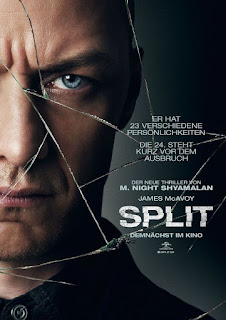Horror- a film that is created to entertain by scaring the audience. Usually, horror can be gory which means LOTS of special effects makeup whether it's blood, gashes, etc.
Thriller- a film intended to scare with suspense.
Common camera angles, shots, and movements in a horror film:
1. Bird's eye view/high angle- these are usually used to show someone on the ground, possibly vulnerable to whatever is above it.
2. Close up- used to show the reactions of the characters.
3. Tracking shot- shows someone being followed.
4. Tilt- can signify a supernatural being.
5. Low angle- shows how intimidating a protagonist is.
6. Hand held- makes the film more realistic; ex. Blair Witch Project
7. POV- the audience is able to be scared exactly like the character
8. Over the shoulder- builds tension, can sometimes signify someone standing behind a person.
Common camera angles, shots, and movements in a thriller:
1. Establishing shot- sets an eerie mood.
2. Tracking shot- shows someone being followed.
3. Close up- used to show the reactions of the characters.
4. Tilt- can signify a supernatural being.
5. Over the shoulder- builds tension, can sometimes signify someone standing behind a person.
Mis en scene in horror movies:
Costumes- sometimes costumes can be very specific to the movie. What I mean by this is that if it's a horror movie with a supernatural protagonist such as Pennywise, the costume will obviously be a clown suit but the supporting characters may have on regular clothes.
Lighting- dark, eerie lighting.
Actors- actors usually vary but the most common thing they do is scream and fight.
Makeup- lots of special effects are used to add to the gory effect of the movie.
Props- whether it's used by the protagonist or the antagonist, there's always weapons used.
Setting- a lot of times in a made up town when including a supernatural being; sometimes secluded.
Mis en scene in thriller movies:
Costumes- usually regular clothes
Lighting- dark, eerie lighting.
Actors- actors usually vary but the most common thing they do is scream and fight.
Makeup- can show dirt or bruises from being chased and fighting back.
Props-whether it's used by the protagonist or the antagonist, there's always weapons used.
Setting- settings vary; sometimes secluded.
Common sounds and editing of horror and thrillers:
1. Diegetic sound- when the actor is quiet and you can hear all of their surroundings.
2. Non diegetic- the sounds of weapons, sounds of supernatural being.
3. Sound Motif
4. Incidental Music- suspenseful music.
5. Dialogue
6. Cutaway
7. Eye- line match
8. Jump cut
9. Reaction shot
Examples of horror films:
“IT”-2017
“The Conjuring”- 2013
“Scary Stories to Tell in the Dark”-2019
Examples of thrillers:
“A Quiet Place”-2018
“Us”-2019
“Extremely Wicked, Shockingly Evil and Vile”-2019
“Split”-2016







No comments:
Post a Comment